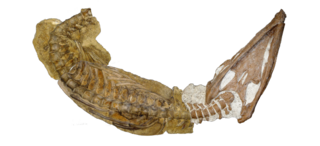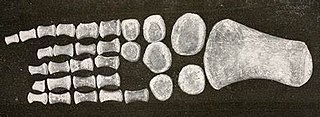
Charles Hazelius Sternberg was an American fossil collector and paleontologist. He was active in both fields from 1876 to 1928, and collected fossils for Edward Drinker Cope and Othniel C. Marsh, and for the British Museum, the San Diego Natural History Museum and other museums.
The Treatise on Invertebrate Paleontology published by the Geological Society of America and the University of Kansas Press, is a definitive multi-authored work of some 50 volumes, written by more than 300 paleontologists, and covering every phylum, class, order, family, and genus of fossil and extant invertebrate animals. The prehistoric invertebrates are described as to their taxonomy, morphology, paleoecology, stratigraphic and paleogeographic range. However, taxa with no fossil record whatsoever have just a very brief listing.

Ichthyornis is an extinct genus of toothy seabird-like ornithuran from the late Cretaceous period of North America. Its fossil remains are known from the chalks of Alberta, Alabama, Kansas, New Mexico, Saskatchewan, and Texas, in strata that were laid down in the Western Interior Seaway during the Turonian through Campanian ages, about 95–83.5 million years ago. Ichthyornis is a common component of the Niobrara Formation fauna, and numerous specimens have been found.

Xiphactinus, colloquially referred to as the X-fish, is an extinct genus of large predatory marine bony fish that lived during the late Albian to the late Maastrichtian. The genus grew up to 5–6 metres (16–20 ft) in length, and superficially resembled a gargantuan, fanged tarpon.

Samuel Wendell Williston was an American educator, entomologist, and paleontologist who was the first to propose that birds developed flight cursorially, rather than arboreally. He was a specialist on the flies, Diptera.
Raymond Cecil Moore was an American geologist and paleontologist. He is known for his work on Paleozoic crinoids, bryozoans, and corals. Moore was a member of US Geological Survey from 1913 until 1949. In 1919 he became professor at the University of Kansas (Lawrence). In 1953 Professor Moore organized the launch and became the first editor of the still ongoing multi-volume work Treatise on Invertebrate Paleontology. Contributors to the Treatise have included the world's specialists in the field. He served as president of the Geological Society of America in 1958. In 1970 he was awarded the Mary Clark Thompson Medal from the National Academy of Sciences.
Asthenoceras is a genus of ammonoid from the Middle Jurassic with dwarfish, evolute, smooth, compressed, discoidal, strongly keeled shell. Asthenoceras belongs to the Sonniniidae and may be a subgenus of the Lower Jurassic Grammoceras.

Brachauchenius is an extinct genus of pliosaurid that lived in North America and Morocco during the Late Cretaceous.

The Pierre Shale is a geologic formation or series in the Upper Cretaceous which occurs east of the Rocky Mountains in the Great Plains, from Pembina Valley in Canada to New Mexico.

Toxochelys is an extinct genus of marine turtle from the Late Cretaceous period. It is the most commonly found fossilized turtle species in the Smoky Hill Chalk, in western Kansas.

Ogmodirus is an extinct genus of plesiosaur found in the Cenomanian-Turonian Greenhorn Limestone of Kansas. The type species, O. martini, was named by Samuel Wendell Williston and Roy Lee Moodie in 1913.
Xiaoming Wang is a Chinese-born American vertebrate paleontologist and geologist who lives and teaches in the United States.

Acroplous is an extinct genus of dvinosaurian Temnospondyli within the family Eobrachyopidae.
Pratifelis is an extinct genus of feline that lived in North America during the middle Miocene period. It contains a single species, Pratifelis martini.
Oceans of Kansas is a book by Michael J. Everhart, Adjunct Curator of Paleontology at the Sternberg Museum of Natural History and past President of the Kansas Academy of Science. It was published in 2005 by Indiana University Press. It has an award-winning, concomitant website entitled Oceans of Kansas Paleontology. A revised, updated, and expanded edition was published in 2017. It is part of the life of the past series.

Perisphinctoidea, formerly Perisphinctaceae, is a superfamily of Middle Jurassic (Bajocian) to Lower Cretaceous (Barremian) ammonites, commonly with evolute shells with strong ribbing that typically divides about mid flank before crossing the venter.

Paleontology in Kansas refers to paleontological research occurring within or conducted by people from the U.S. state of Kansas. Kansas has been the source of some of the most spectacular fossil discoveries in US history. The fossil record of Kansas spans from the Cambrian to the Pleistocene. From the Cambrian to the Devonian, Kansas was covered by a shallow sea. During the ensuing Carboniferous the local sea level began to rise and fall. When sea levels were low the state was home to richly vegetated deltaic swamps where early amphibians and reptiles lived. Seas expanded across most of the state again during the Permian, but on land the state was home to thousands of different insect species. The popular pterosaur Pteranodon is best known from this state. During the early part of the Cenozoic era Kansas became a savannah environment. Later, during the Ice Age, glaciers briefly entered the state, which was home to camels, mammoths, mastodons, and saber-teeth. Local fossils may have inspired Native Americans to regard some local hills as the homes of sacred spirit animals. Major scientific discoveries in Kansas included the pterosaur Pteranodon and a fossil of the fish Xiphactinus that died in the act of swallowing another fish.

The Fort Hays Limestone is a member of the Niobrara Formation of the Colorado Group exposed in Colorado, Kansas, Nebraska, and South Dakota and is named for the bluffs near the old Fort Hays, a well-known landmark in western Kansas.











